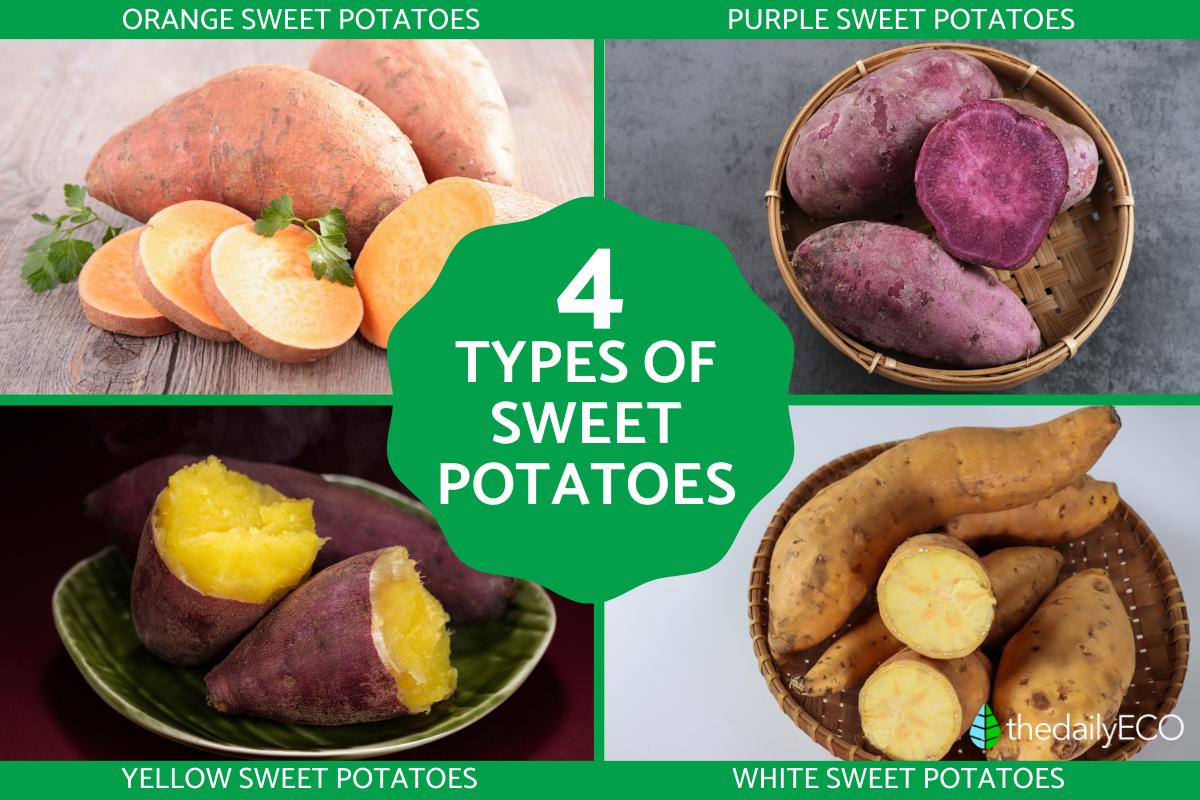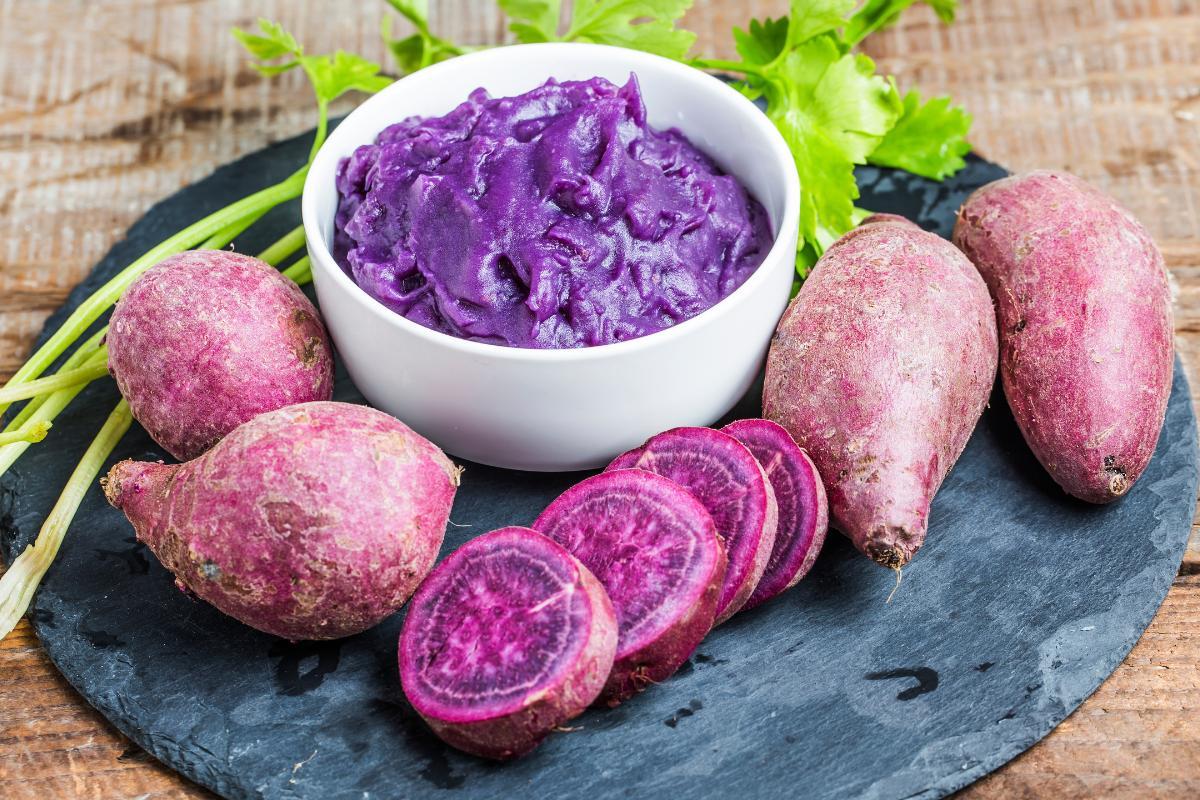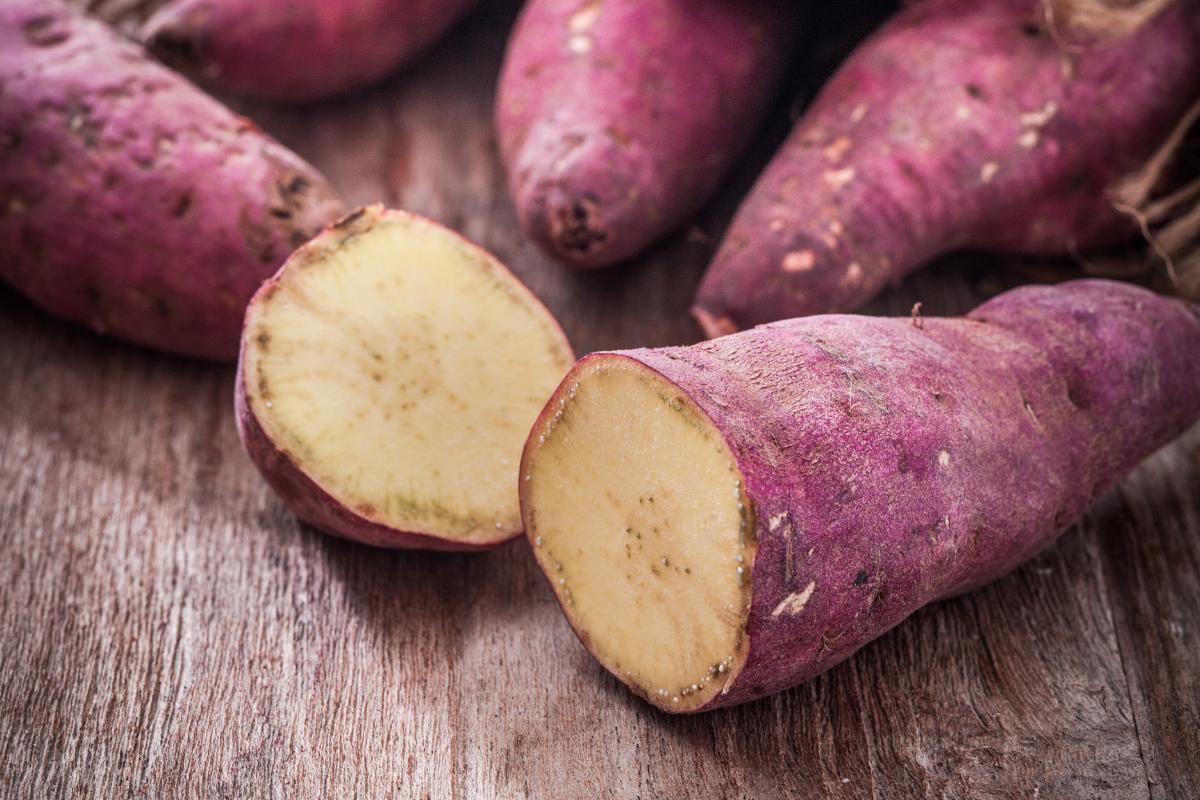Different Types of Sweet Potato


Orange-fleshed sweet potatoes are well-known for their vibrant color and sweet, earthy taste. However, there's a variety of sweet potatoes to discover. Purple sweet potatoes feature a striking violet hue and a blend of earthy sweetness with antioxidants. White sweet potatoes, often called "boniato," offer a milder sweetness and nutty undertones. Yellow sweet potatoes, with their pale golden flesh, bring a delicate sweetness and versatility in cooking.
In this article from thedailyECO, we'll take a look at the four main types of sweet potatoes based on their color and the flavors that come with them. We'll also explore what makes each type unique and how you can use them in your cooking.
Orange sweet potatoes
Orange sweet potatoes are a colorful and nutrient-rich vegetable, widely appreciated for their health benefits and culinary versatility.
These sweet potatoes are particularly valued for their high concentration of β-carotene, a precursor to vitamin A, a crucial nutrient for maintaining healthy vision, promoting skin health, and supporting a robust immune system. The distinctive deep orange color of these sweet potatoes is a direct result of their rich β-carotene content.
Furthermore, β-carotene not only contributes to the appealing color but also possesses potent antioxidant properties. These antioxidants help neutralize harmful free radicals in the body, promoting overall health and well-being.
In addition to their nutritional value, orange sweet potatoes have gained widespread popularity for their delectable taste and culinary adaptability. They can be prepared in a variety of ways, from roasting and baking to mashing and creating delectable dishes like sweet potato pies and casseroles. Their mild sweetness and earthy flavor make them a versatile ingredient in both savory and sweet recipes.
Varieties of orange-fleshed sweet potatoes include:
- Jewel: this variety produces elongated, elliptical-shaped tuberous roots with a thick outer skin and is known for its high yield.
- Centennial: this variety is characterized by its mild and subtly sweet flavor, making it a popular choice for traditional dishes like sweet potato pie.
- Georgia jet: this variety is distinguished by its smooth, deep red skin and vibrant orange-toned flesh.
- Beauregard: this variety is widely favored for its exceptionally sweet flavor and soft, velvety texture, making it a versatile ingredient in various culinary creations, from cakes to purees.
It is important to note that these varieties of orange-fleshed sweet potatoes have their origins and breeding programs primarily in the United States. However, they are now cultivated in various regions worldwide, depending on local climate and growing conditions.

Purple or blue sweet potatoes
Purple or blue sweet potatoes are a unique and nutritious variety of sweet potatoes. Their striking, vibrant purple or blue flesh is due to their high content of anthocyanins, which are natural pigments with antioxidant properties. These antioxidants can help combat oxidative stress and promote overall health.
Purple or blue sweet potatoes are also packed with essential nutrients. They offer dietary fiber, vitamins (such as A and C), and important minerals like potassium and manganese. Some studies suggest that the antioxidants in purple or blue sweet potatoes may have potential health benefits, such as reducing inflammation, supporting cognitive function, and contributing to cardiovascular health.
Their flavor is sweet and slightly nutty, with a touch of earthiness, making them a versatile addition to various dishes.
These sweet potatoes can be prepared similarly to other types of sweet potatoes, whether roasted, baked, mashed, or used in both sweet and savory recipes. Their unique color makes them a favorite for adding a pop of color to salads, side dishes, and desserts.
Various other purple or blue sweet potato varieties have been developed over the years, with subtle differences in appearance and taste. Popular purple or blue sweet potato varieties include:
- Okinawan purple sweet potatoes: these Japanese natives boast deep purple skin and vibrant purple flesh, known for their high antioxidant content and earthy-sweet flavor.
- Stokes purple sweet potatoes: similar in appearance to Okinawan sweet potatoes, they feature purple skin and rich purple flesh. Named after their discoverer, they are prized for their unique color and earthy-sweet taste.
Both varieties are versatile culinary ingredients, adding vibrancy and sweetness to savory and sweet dishes. Their starchy texture makes them ideal for pies, casseroles, and natural food coloring.
Discover the amazing diversity of pumpkins, from the large to the petite, and explore their culinary flexibility in this separate article.

Yellow sweet potatoes
Yellow sweet potatoes, with their pale yellow or light golden flesh, offer a unique culinary experience. Their mild, subtly sweet taste and smooth, creamy texture make them a versatile ingredient in various dishes.
Yellow sweet potatoes are appreciated for their versatility in cooking methods, from roasting and baking to mashing and incorporating into both sweet and savory creations. Their delicate flavor complements a wide range of ingredients, adding a subtle sweetness and creamy texture to dishes.
While they may not possess the same vibrant color and high β-carotene content as orange sweet potatoes, yellow sweet potatoes still provide essential vitamins and minerals, including vitamin A, vitamin C, dietary fiber, and antioxidants.
Yellow sweet potatoes come in various cultivars, each with slightly different characteristics and flavor profiles. Here are a few notable varieties:
- Hannah: this variety features light yellow skin and pale yellow flesh with a slightly dry texture. It has a mild, sweet flavor and is suitable for roasting, baking, and mashing.
- Butterscotch: true to its name, this variety offers a buttery, sweet flavor with a creamy texture. Its skin is light yellow, and its flesh is a deeper shade of yellow. It is versatile for roasting, baking, and mashing.
- Sunshine: this variety boasts a vibrant yellow skin and a deep golden yellow flesh. It has a slightly sweet, nutty flavor and a moist, creamy texture. It is excellent for roasting, baking, and mashing.
- Beauregard: while primarily known for its orange-fleshed variety, Beauregard also has a yellow-fleshed cultivar. It has a slightly sweet, earthy flavor and a moist, creamy texture. It is suitable for roasting, baking, and mashing.
The availability of yellow sweet potatoes may vary by region, but they are cultivated and enjoyed in many parts of the world.

White sweet potatoes or boniato
White sweet potatoes, also known as "boniato," have pale cream-colored or white flesh, which distinguishes them from the more common orange-fleshed sweet potatoes. While they may not be as widely recognized as other sweet potato varieties, white sweet potatoes have their own unique attributes.
White sweet potatoes are characterized by their mild and slightly sweet flavor. Some people prefer white sweet potatoes for their less sweet and nuttier taste compared to other sweet potato varieties.
White sweet potatoes are not just a culinary delight, but also a source of essential nutrients. They are rich in dietary fiber, which aids in digestion and promotes gut health. They also contain vitamins and minerals, including vitamin C, potassium, and manganese, contributing to overall well-being.
White sweet potatoes are commonly used in Latin American and Caribbean cuisines and are a popular ingredient in dishes like yam fries, stews, and various side dishes.
There are several varieties of white sweet potatoes, each with slightly different characteristics and flavor profiles. Here are a few notable examples:
- O'Henry: this variety is known for its dry, starchy texture and mild, nutty flavor. It is a popular choice for roasting, baking, and mashing.
- Bonita: this variety has a slightly moister texture and a subtly sweet flavor with hints of chestnut. It is versatile for roasting, baking, and mashing.
- Jersey: this variety features a creamy texture and a slightly sweet, earthy flavor. It is suitable for roasting, baking, and mashing.
These are just a few examples of the diverse white sweet potato varieties available. Each cultivar offers unique flavor nuances and culinary applications, making them a versatile ingredient for various dishes.
Delve into the delightful array of autumn fruits and enjoy the season's harvest in this other article.

If you want to read similar articles to Different Types of Sweet Potato, we recommend you visit our Healthy foods category.
- Cobeña Ruiz, G., Cañarte Bermúdez, E., Mendoza García, A., Cárdenas Guillen, FM, & Guzmán Cedeño, Á. (2017). “Technical manual for sweet potato cultivation.”
- Folquer, F. (1978). “The sweet potato (sweet potato): study of the plant and its commercial production.”
- León, MM (2014). “Anti-inflammatory activities of purple sweet potato (Ipomea batatas) and black carrot (Daucus carota ssp. sativus) on intestinal myofibroblast cells.”









